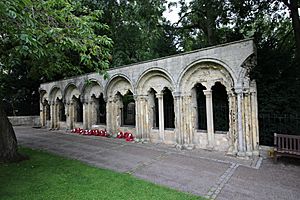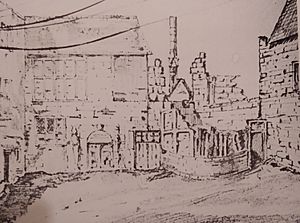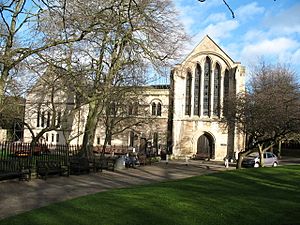Archbishop's Palace, York facts for kids
The Archbishop's Palace was a grand home for the Archbishop of York many years ago, during the Middle Ages. It was located right next to York Minster, and today, the area where it stood is known as Dean's Park.
Contents
Building the Archbishop's Palace
York Minster was badly damaged by a fire in 1137. Roger de Pont L'Évêque, who was the Archbishop of York from 1154 to 1181, helped rebuild the Minster. It seems he also started building the palace around this time.
In 1179, a special college and chapel called St Mary and All Angels (also known as St Sepulchre) was built next to the palace. Their stories became linked together. Later, in 1268, the palace grounds were made even bigger, reaching all the way to the city walls.
What Was the Palace Used For?
The Archbishop's Palace was used for many different things over the years.
- In 1275, important court hearings were held there.
- From 1327 to 1328, King Edward III used the palace as his main base while he was leading a campaign against the Scots. The palace was changed a lot and cost a lot of money to get ready for him.
- By 1385, the palace also had the archbishop's own prison, possibly in a secret underground room below St Sepulchre's Chapel.
- In 1400, a new room was added so King Henry IV could watch exciting knight tournaments held in the palace grounds.
- Other famous people who stayed at the palace include King Richard III in 1483, King Henry VII in 1487, and Margaret Tudor in 1503.
Changes Over Time
St Sepulchre's College closed down in 1547. In the 1560s, Archbishop Thomas Young took the lead off the palace's roof. People say he did this to buy another house called Grays Court for his son, George. He might have even used stones from the palace to build it.
By 1616, the palace was falling apart. The land was then sold to Arthur Ingram. He rebuilt part of the palace as his own house and created beautiful gardens in the rest of the grounds. These gardens included a fishpond, a tennis court, and a bowling green.
King Charles I stayed in Ingram's house in 1642. After Ingram died, his family split the property into smaller homes and rented them out.
Later Years and Dean's Park
In 1734, a theatre was built where the tennis court used to be. In 1780, the palace's old great hall was rebuilt as a riding school. This riding school became famous in 1785 for an early balloon ascent! In 1799, a huge painting showing the Royal Navy's ships was displayed there. By this time, Ingram's house was mostly in ruins.
York Minster bought the whole area in 1814. They pulled down Ingram's house and the riding school, using the space for storing building stones. The old chapel of the palace was fixed up and became the Minster's library. It is now known as the Old Palace. In 1823, the rest of the land was turned back into gardens, called the Deanery Gardens. When some old sheds were knocked down, they found a beautiful archway from the original 12th-century palace.
More recently, the grounds have become known as Dean's Park. During World War II, the park was dug up to hold water tanks, but it has since been restored. In 1987, the old archway was made into a special war memorial for people who died in the World Wars and other wars from the 1800s. Since 1997, it has been recognized as a very important historical building.




